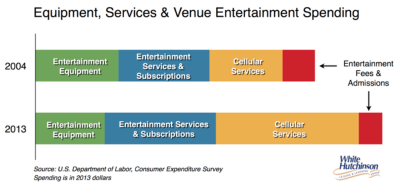
Vol. XV, No. 1, January 2015
- Editor's corner
- There's still time to register for FEC education for success
- Understanding the value of experiences
- Paper trumps plastic
- Immersive experiences continue as major trend with escape games
- A paradigmatic shift for entertainment venues; the entertainment is now secondary
- The changing American family
- Feasibility studies aren't what they used to be
- Why spending on tech equipment is so appealing
- Beer preferences
- Beer pong goes high-tech
Why spending on tech equipment is so appealing
In 2013, average household purchases of all types of entertainment equipment, including cellular phone, video gaming, audio and visual equipment, was three times the average household spending on fees and admissions to entertainment venues (entertainment venue fees). If we add entertainment downloads, subscription and streaming services (including video, TV, radio, online gaming and audio but not cellular) to entertainment equipment purchases (EESS for entertainment equipment, subscriptions and services), they total more than six times the household spending on entertainment venue fees and from 2004 to 2013 they have grown from 3% of all household expenditure to 4%.
Meanwhile over the ten years since 2004, inflation-adjusted household spending on entertainment venue fees has declined by almost one-quarter.
How can this be? What is the growing attraction of EESS all about and why are many consumers shifting their spending to EESS rather than to attending an entertainment venue?
Numerous studies have shown that spending discretionary money on life experiences instead of material goods leads to more happiness and wellbeing. Experiences increase pleasure and happiness as they satisfy the psychological needs of autonomy, competence and social relatedness.
Research has found that there is a distinct category of material goods known as experiential goods that enable you to have experiences and can make you just as happy as life experiences. Think of a video game. Video games are often purchased with the intention of being consumed with others as well as offering challenges. Sports equipment is another category of experiential goods. It enables to you have a social experience and be challenged to acquire skills.
Experiential goods that allow you to have social experiences and/or share the experience with others make people happier just like real world social experiences themselves. Such social experiential products provide the same amount of well-being as do social life experiences because they both meet the need for relatedness. The inclusion of others, socialization, is how people derive happiness and value from any type of discretionary spending. Any type of social discretionary spending is favored over solitary discretionary spending. Spending money on socially shared experiences is valued more than spending money on either experiences enacted alone or material possessions. Solitary experiences are no more valued than material possessions.
So getting back to EESS (entertainment electronic equipment, services and subscriptions); when we examine their nature, most fall within the realm of socialization and relatedness. So they are just as valued as the social experience of attending most entertainment venues.
However, experiential EESS are gaining a spending market share over entertainment venues. One reason could very well be they offer a greater value per dollar. Think of a television. Once you purchase it and subscribe to cable, you can use it for thousands of hours a year. The average adult watches television 1,962 hours per year. If you use it over three years and an average of two people watch it at once, the cost of the TV plus the cable subscription could be less than $0.40 per hour of use per person. That is a lot less expensive than attending either an entertainment venue or sporting events that can easily cost between $5 and $20 per hour per person. And it sure is a lot more convenient as you don't have to leave your home.

Another technology that is gaining spending share is cellular phone services. Inflation-adjusted spending for cellular services has almost doubled over ten years and in 2013 was 1.8% of all household expenditures, six times the average household spending on entertainment venues. Cellular phones offer both entertainment as well as socialization by voice conversation and texting and on social media. More and more people are defining themselves and constructing their identities as well as gaining social klout by the experiences they have and share, most of the sharing taking place on smartphones. The social aspect of using smartphones is what gives them such great value.
So, we believe the bottom line of why discretionary spending on digital technology equipment, services and subscriptions is going up and spending for fees and admissions to entertainment venues is on the decline is that the digital equipment falls into the category of experiential goods with the services and subscriptions becoming a part of the experiential good experience and the enjoyment of the equipment experience is valued as much as the real life experience of attending an entertainment value, but is far less costly and far more convenient.
To win the war for a greater share of discretionary entertainment spending as well as leisure time, entertainment venues need to enhance their value. This includes both on the social scale as well as adding experiences that can't be enjoyed in the digital world, mainly food and beverage experiences. They also have to raise the overall quality of the experiences they offer to a premium, High Fidelity level.
Also see our article in this issue: Understanding the value of experiences
Additional reading:
Vol. XV, No. 1, January 2015
- Editor's corner
- There's still time to register for FEC education for success
- Understanding the value of experiences
- Paper trumps plastic
- Immersive experiences continue as major trend with escape games
- A paradigmatic shift for entertainment venues; the entertainment is now secondary
- The changing American family
- Feasibility studies aren't what they used to be
- Why spending on tech equipment is so appealing
- Beer preferences
- Beer pong goes high-tech


